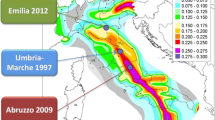Abstract
Quantitative estimates of potential losses that may be caused by future great earthquakes along the Himalaya suggest that as many as 150,000 people may die, 300,000 may be injured and typically 3,000 settlements will be affected in a single event. Scenario results used here vary and are based on ruptures of 150 km segments of the plate boundary at seven positions, where sufficient elastic energy is believed to be stored for magnitude eight earthquakes. The method of calculating these results was calibrated, using the 17 disastrous Indian earthquakes, which have occurred since 1980. About 50 settlements in the region are considered most at risk because in each more than 2000 fatalities may occur.
Similar content being viewed by others
References
N.N. Ambraseys J. Douglas (2004) ArticleTitleMagnitude calibration of north Indian earthquakes Geophys. J. Int. 159 165–206
Bhatia, S. C., Kumar, M. R., and Gupta, H. K.: 1999, A probabilistic seismic hazard map of india and adjoining regions, pp. seismo.ethz.ch/gshap/ict/india.html#souces_zones, National Geophysical Research Institute, Hyderabad
R. Bilham V.K. Gaur P. Molnar (2001) ArticleTitleHimalayan seismic hazard Science 293 1442–1444
R. Bilham (2004) ArticleTitleEarthquakes in India and the Himalaya: tectonics, geodesy and history Annals of Geophysics 47 IssueID2 839–858
K.N. Khattri (1999) ArticleTitleProbabilities of occurrence of great earthquakes in the Himalaya Current Science 77 967–972
V. Larionov N. Frolova A. Ugarov (2000) Approaches to vulnerability evaluation and their application for operative forecast of earthquake consequences A. Ragozin (Eds) All-Russian conference “Risk-2000” ANKIL Moscow 132–135
Shakhramanjyan, M. A., Nigmetov, G. M., Larionov, V. I., Frolova, N. I., Suchshev, S. P., and Ugarov, A. N.: 2001, Seismic and complex risk assessment and management for the Kamchatka region, in XII World Conference on Earthquake Engineering, Auckland, New Zealand
M.A. Shakhramanjyan G.M. Nigmetov V.I. Larionov A.V. Nikolaev N.I. Frolova S.P. Sushchev A.N. Ugarov (2001) ArticleTitleAdvanced procedures for risk assessment and management in Russia International Journal of Risk Assessment and Management 2 IssueID3/4 303–318
M. Wyss (1979) ArticleTitleEstimating expectable maximum magnitude of earthquakes from fault dimensions Geology 7 336–340
M. Wyss (2004) Real-time prediction of earthquake casualties D. Malzahn T. Plapp (Eds) Disasters and Society – From Hazard Assessment to Risk Reduction Logos Karlsruhe 165–173
Author information
Authors and Affiliations
Corresponding author
Rights and permissions
About this article
Cite this article
Wyss, M. Human Losses Expected in Himalayan Earthquakes. Nat Hazards 34, 305–314 (2005). https://doi.org/10.1007/s11069-004-2073-1
Received:
Accepted:
Issue Date:
DOI: https://doi.org/10.1007/s11069-004-2073-1




